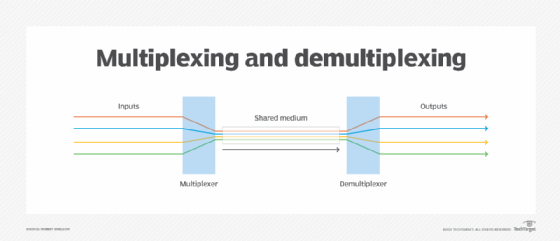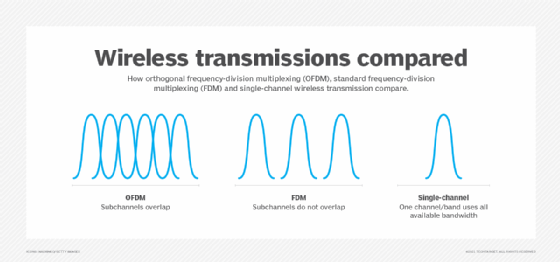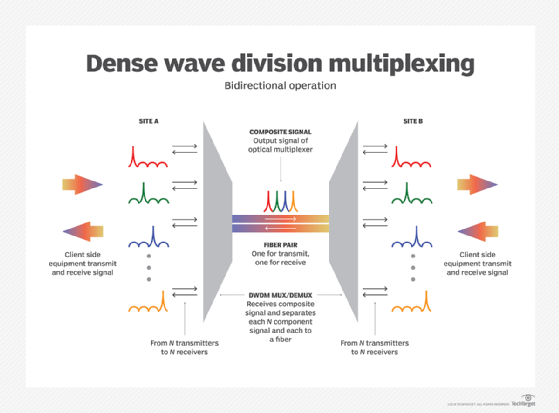Multiplexing, or muxing, is a way of sending multiple signals or streams of information over a communications link at the same time in the form of a single, complex signal. The goal is to enhance the channel’s transmission efficiency and speed, even over long distances.
When the composite signal reaches its destination, a process called demultiplexing, or demuxing, recovers and restores the separate signals and outputs them to individual lines.
What is multiplexing in simple words?
Multiplexing is a method used by networks to consolidate multiple signals — digital or analog — into a single composite signal that is transported over a common medium, such as a fiber optic cable or radio wave.
This single composite link, which can come from multiple sources, allows the signals to share bandwidth, which then enhances the network’s capacity as well as data transmission efficiency and speed.
How does multiplexing work?
Networks use a variety of multiplexing techniques. For example, in time division multiplexing (TDM), a single communication channel is divided into multiple time slots, with each signal assigned to a slot and then sent along the channel in a sequential or cyclical manner. The various signals operate at the same frequency but are sent at different times. On the other hand, in frequency division multiplexing (FDM), the available frequency spectrum is divided into multiple frequency channels or bands, with each channel carrying a signal of a specific frequency, with strips of bandwidth called guard bands placed between each channel to minimize inter-channel crosstalk.
The multiplexed signals might contain audio, video or data. Regardless, the signal is first muxed and then demuxed. Also, each signal is assigned a distinct identifier to enable efficient muxing and error-free demuxing. The identifier is a time slot if TDM is used, a frequency band in FDM, a wavelength in WDM, and so on.

These differences notwithstanding, multiplexed networks all operate in a similar manner at a conceptual level. First, the communication channel is divided into multiple logical channels. Then, the individual electrical or electromagnetic network signals are input into a multiplexer (mux) that combines them into a composite signal. The conductor used to transmit the signal is often a copper wire or a fiber optic cable.
After the signals pass through the mux, the composite signal generated is transmitted through a shared medium. When the signal reaches its destination, a demultiplexer (demux) splits the signal back into the original component signals and outputs them into separate lines for use by other operations.
What is multiplexing used for? Real-world applications
Multiplexing is used in a wide range of industries to facilitate both analog and digital communications, particularly in environments where bandwidth is limited, and its efficient use is desirable. The concept was first introduced in the 1870s to support telegraphy but has since become a mainstay in modern telecommunications and broadcasting applications, such as radio, television and telephone.
Multiplexing is also used in computer networks, often to transmit multiple signals across a wide area network (WAN). In internet communications, muxing provides a way to transmit data from multiple users over a single shared channel, thus improving network capacity and increasing data transfer speeds.
Increasingly, multiplexing is also being used in satellite communications. Muxing provides the benefits of higher speeds and improved bandwidth efficiency in satellite networks by making it possible to transmit and receive multiple signals simultaneously over a single channel.
Another emerging application of the basic idea of multiplexing is blockchain. For example, the ALDER protocol multiplexes multiple permissionless blockchain protocols in order to alleviate performance bottlenecks and improve blockchain throughput and performance.
What are the types of multiplexing?
Organizations can select from multiple forms of multiplexing. Their choices will largely depend on the types of signals being transmitted — analog versus digital — and the media used to carry those transmissions, such as coaxial cable, fiber optic cable or microwave link.
The following is an overview of several common multiplexing techniques.
Frequency-division multiplexing (FDM)
Bandwidth on a communications link is divided into subchannels of different frequency widths, each carrying a signal in parallel with the other signals. Analog radio transmissions commonly use FDM to multiplex signals across radio waves. Analog cable TV also uses FDM, sending multiple channels down the same strands of coaxial cable. An offshoot of FDM is orthogonal frequency-division multiplexing (OFDM), which transmits subchannel frequencies closer together, while enabling them to overlap and still remain separate.
Inter-channel crosstalk is a common problem with FDM. This is because the available bandwidth or frequency spectrum is divided into multiple frequency channels, with each channel carrying a signal of a different frequency. To minimize interference between signals, adequate spacing must be maintained between frequencies. This is done by placing unused frequency strips called guard bands between frequencies.

Wavelength-division multiplexing (WDM)
Multiple communications channels are consolidated and then transmitted on lightwaves with different wavelengths. Conceptually, this is similar to FDM, except that FDM is described in terms of frequencies — radio or television broadcasting, for example — whereas WDM is specific to wavelengths. The WDM approach is more common in telecommunication systems and computer networks that use laser systems to send light signals over fiber optic cables. WDM variations include coarse WDM and dense WDM (DWDM), which put fewer or more channels of information, respectively, on the medium at the same time.
Time-division multiplexing (TDM)
Multiple digital signals are transmitted over the same channel in alternating time slots. They thus share the channel’s bandwidth and operate with the same frequency, albeit at different times. TDM operates at the temporal level, unlike FDM and WDM, which operate at the frequency or wavelength level. Although TDM has its roots in telegraphy, it is now commonly used in digital telephony to transmit multiple conversations across a common medium. TDM is also used on Synchronous Optical Network links, which were once the mainstay of enterprise WAN and internet connectivity.
TDM can be either synchronous or asynchronous. In synchronous TDM, multiple time slots are grouped into frames, with each frame separated into multiple slots and every signal sampled at the same speed. In asynchronous TDM, the sampling speed is different for different signals. Also, if nothing is to be transmitted by a device, the available time slot is not left empty but assigned to a new device. This chief difference accounts for the higher bandwidth utilization and efficiency of asynchronous TDM.

Code-division multiplexing (CDM)
A sequence of bits called the spreading code is assigned to each signal to distinguish one signal from another. The spreading code is combined with the original signal to produce a new stream of encoded data, which is then transmitted on a shared medium. A demux that knows the code can then retrieve the original signals by subtracting out the spreading code, a process called dispreading. CDM is widely used in digital television and radio broadcasting and in the third generation (3G) mobile cellular networks — 4G and 5G primarily use OFDM. CDM can also support multiple signals from multiple sources, a technique known as code-division multiple access.
Space-division multiplexing (SDM)
Signal paths are spatially separated through the use of multiple conductors, such as optical fibers or electrical wires. The conductors are bundled into a single transport medium but are physically separated, with each conductor handling a transmitted channel. Individual conductors can be further multiplexed using FDM, TDM or other techniques. SDM is often used in submarine cable systems to help increase capacity, but it can also be used for wireless communications.
Polarization-division multiplexing (PDM)
Incoming electromagnetic signals are polarized into orthogonal channels that are transmitted through a common medium. PDM is frequently used in fiber optics communications, as well as radio and microwave transmissions. For example, satellite TV providers often use PDM to deliver TV signals to satellite dishes.
Advantages of multiplexing
Multiplexing offers numerous advantages for both digital and analog communications. The practice of transmitting multiple signals over a single communication channel increases the transmission capacity of that channel, regardless of whether it is used in a wired system, a wireless system, a telecom network, a WAN, an optical circuit or satellite/space communications. Also, since multiple signals share the same channel, the available bandwidth can be utilized more efficiently.
The consolidation of multiple signals increases data transfer speeds. The use of a single transmission medium also reduces the need for additional physical connections and frequency allocations. If additional users or services are to be added, it can be done without making substantial changes to the system, providing the scalability and flexibility needed for modern communication applications. It also saves resources and reduces costs while ensuring high-speed and reliable data transfers and communication.
In general, organizations implement multiplexing on their networks for two reasons:
- To enable network devices to communicate with each other without needing a dedicated connection between each device pair, although multiplexing still requires shared media.
- To better utilize scarce or expensive network resources. For example, multiplexing can be used to transmit multiple signals across a satellite uplink or on a cable or fiber strand running between major metropolitan areas.
Disadvantages of multiplexing
Its many advantages notwithstanding, multiplexing also has some disadvantages that need to be considered. System complexity and cost is one potential disadvantage. As the number of signals or users increases, planning, configuring, managing and maintaining multiplexed systems can be complex and costly.
Signal interference, crosstalk, data losses and errors are also possible drawbacks of multiplexing. Also, combining multiple data streams can result in undesirable latency. To prevent such issues, various data streams must be properly separated and synchronized. It might also be necessary to place guard bands. All of this can involve technically demanding and complex effort.
As distances increase, the system’s costs and complexity can go up further. Signals that are sent over longer distances might experience degradation and interference, affecting quality at the receiving end. Signal boosters or repeaters can help to maintain signal quality. However, these measures increase costs and make the system harder to configure and manage.
Bandwidth and throughput both represent aspects of network performance. While the terms are often used interchangeably, bandwidth refers to the maximum capacity of the network, whereas throughput indicates the actual amount of data transmitted over time. Explore the difference between bandwidth vs. throughput.
























